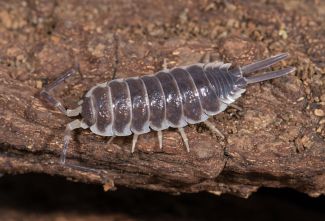Difference between revisions of "Porcellio hoffmannseggii"
Jump to navigation
Jump to search
| Line 29: | Line 29: | ||
==Taxonomy== | ==Taxonomy== | ||
===Classification=== | |||
Taxonomic characters of ''Porcellio hoffmannseggii'' are: | |||
*{{oniscidea}} | |||
*{{crinocheta}} | |||
*{{porcellionidae}} | |||
*{{porcellio}} | |||
===Morphology== | |||
(which characters are most useful for IDs at every level?) | (which characters are most useful for IDs at every level?) | ||
* | *{{morphology}} | ||
* | *{{morphology}} | ||
* | *{{morphology}} | ||
etc. This section really needs to be looked at by someone like Sumeriandemon before we get a template going. | etc. This section really needs to be looked at by someone like Sumeriandemon before we get a template going. | ||
Revision as of 22:28, 13 March 2023
Porcellio hoffmannseggii is a species of Giant Porcellio primarily native to the southernmost third of Spain. Also known as “titan" isopods, they are one of the simplest and most iconic species of large Porcellio. Porcellio hoffmannseggii is one of a number a species often claimed as the largest isopod in the hobby. Porcellio hoffmannseggii is very frequently misspelled, usually missing one of the doubled letters.
General Information
Description
Background
Taxonomy
Classification
Taxonomic characters of Porcellio hoffmannseggii are:
- Its suborder is Oniscidea, which means it is fundamentally characterized by a number of key adaptations to terrestrial life.
- Its zoosection is Crinocheta, which means it belongs to the largest individual lineage of terrestrial isopods, typically unified by the presence of three (or sometimes 4) flagellomeres.
- Its family is Porcellionidae, which means it has "double-jointed" antennae, two pairs of pleopodal lungs, and a flattened body with which it is unable to conglobate.
- Its genus is Porcellio, which means something to somebody, I hope.
=Morphology
(which characters are most useful for IDs at every level?)
Untitled Untitled Untitled
etc. This section really needs to be looked at by someone like Sumeriandemon before we get a template going.Varieties
Name Type In Hobby Originator Market(s) Notes Porcellio hoffmannseggii hoffmannseggii Nominate Since 2015 ? US, CA, UK, EU, SEa Canonical variety. Porcellio hoffmannseggii sordidus Subspecies Yes Let Me Bug You UK, EU Granulated appearance. Porcellio hoffmannseggii "Chocolate" Morph Yes Smug Bug US, CA, UK, EU, SEa Isolated from natural color variation. 'Porcellio hoffmannseggii "Orange" Morph Yes ? UK, EU, SEa Isolated from mutation. 'Porcellio hoffmannseggii "Black" Locality Yes ? US, CA, UK, EU, SEa Non-canonical wild type. 'Porcellio hoffmannseggii "Yeti" Morph Yes ? UK, EU Whiteout mutation. Care Guide
What if I don't care?
Trivia
- Get your own.
Media
Gallery
Video
Sources
Where I'd put sources, had I used any.
